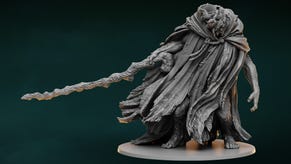Elden Ring is so big, its board game’s first box will only include two of the video game’s starting areas
Initial release will focus on Limgrave and the Weeping Peninsula, with future releases set to delve further into the Lands Between.
Elden Ring: The Board Game’s first box will focus on just two of the video game’s starting regions due to the size of its open world, the designer of the upcoming adaptation has revealed.
Unveiled last month, the Elden Ring board game is a tabletop translation of Dark Souls developer From Software’s latest fantasy RPG video game, released earlier this year to widespread critical acclaim - and chart-topping sales figures to match.
Elden Ring: The Board Game is in the works at Steamforged Games, the Manchester tabletop studio behind Dark Souls: The Board Game and this year’s Dark Souls: The RPG, as well as adaptations of other video games from Devil May Cry and Horizon Zero Dawn to Monster Hunter.
While the game’s initial reveal and subsequent details touched on its introduction of a new card-driven combat system - contrasted with the Dark Souls board game’s use of dice - inclusion of a non-linear campaign mode and increased focus on exploration in line with Elden Ring’s vast open world, Steamforged had remained largely quiet on exactly how battles and exploration would work on the tabletop.
Until now, that is, as a new blog post from lead designer Sherwin Matthews shed light on the mechanics of Elden Ring: The Board Game’s card combat - along with the reveal that the game’s first box will only include part of its vast world for players to traverse.
Battles in the board game will see players each utilise a unique deck of cards, with the exact makeup of cards based on their character’s inventory of weapons, equipment, consumables - crafted from resources collected during their travels, as in the video game - and ashes of war, matching the customisable weapon skills seen on screen.
The cards in a deck will determine the character’s available attacks, as well as their effective range and speed, with players drawing from a separate deck to calculate the damage of successful attacks. This damage deck will similarly be modified as players level up and increase their character’s stats.

Matthews also detailed Elden Ring: The Board Game’s exploration, which will make use of modular map tiles placed as players’ Tarnished venture across the Lands Between. The designer said that tiles would act as both game board and map, with the option to revisit already explored locations or discover new areas.
These areas will provide resources specific to each region - which can be crafted into useful items or used to upgrade equipment - and encounters with other non-player characters such as merchants, random NPCs and enemies. Matthews’ designer diary revealed a new miniature for one such foe: a troll, typically seen wandering the world or pulling loot-bearing wagons.
“So much of the video game is spent travelling from place to place, seeking out new locations, landmarks, enemies, and characters,” Matthews said. “The board game needed to deliver that same sense of wonderment at seeing what lies beyond the horizon, and feeling of excitement when you discover something new - be that rare resources, a dungeon, an enemy encampment, or any of the other myriad sites of interest in the game.”

Given the size of Elden Ring’s world, Matthews confirmed that the board game’s first release would only focus on two regions: the starting area of Limgrave first encountered by the player, and the southern Weeping Peninsula, also typically visited during the earlier hours of the video game.
“We didn’t want you to feel like you’d missed large chunks of the game purely because we were trying to fit everything onto the tabletop all at once and couldn’t possibly include every boss, enemy, weapon, and location,” the designer explained. “We were also extremely conscious of how attempting to do so would bloat the project massively into something quite confusing and unmanageable - both for backers, and from a logistics perspective.”
Matthews said that future releases would expand the world to include other areas of the Lands Between seen in Elden Ring, claiming that breaking the world into a series of boxes would provide the “deep and individually detailed regions the space and attention they deserve”. No information was given on what regions the game’s second box will include, or the format of the releases.
Steamforged recently revealed that the Elden Ring board game will launch on Kickstarter on November 22nd. A release date and price are yet to be announced.



